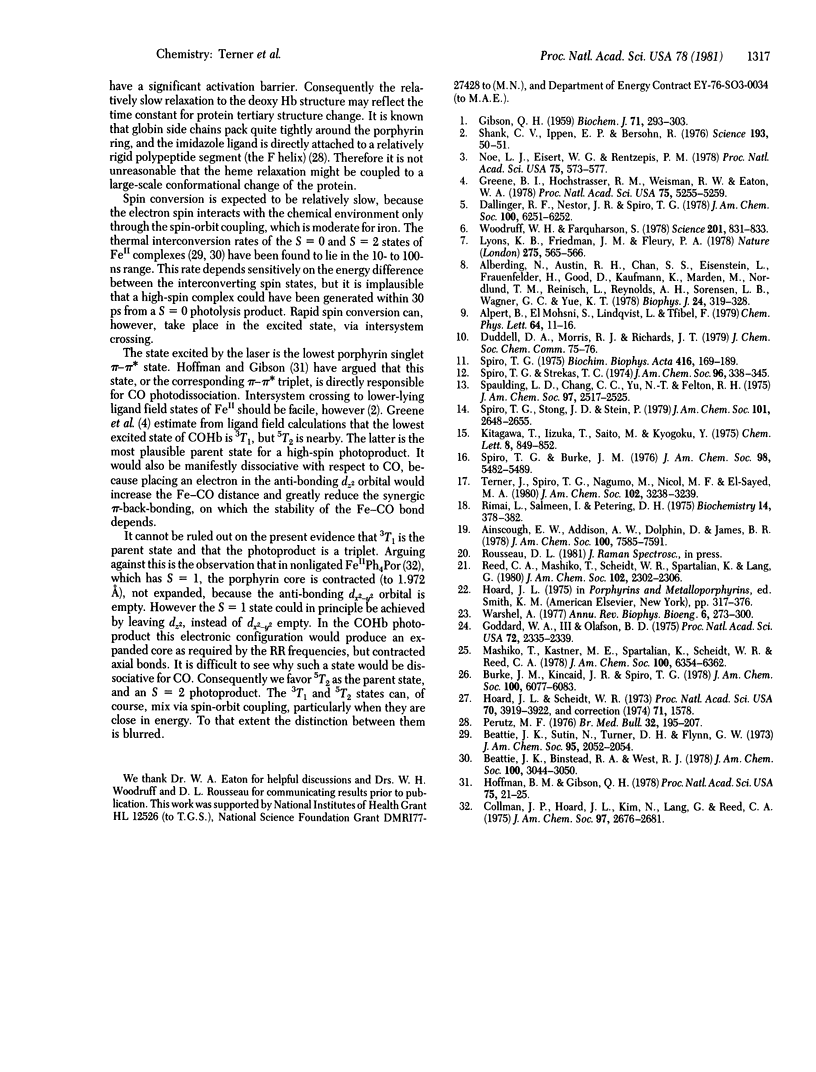Abstract
The structure of the carbonmonoxy-hemoglobin (COHb) photoproduct has been studied on the picosecond time scale with resonance Raman spectroscopy, by tightly focusing the 30-ps pulses of a synchronously pumped mode-locked cavitydumped dye laser on a jet stream of COHb solution. The spectrum of the photoproduct is similar to that of deoxy Hb, but the frequencies 1603 cm-1 (depolarized), 1552 cm-1 (anomalously polarized), and 1542 cm-1 (depolarized) are 2-4 cm-1 lower than those of deoxy Hb. Similar low frequencies are observed for a species believed to be the bis-tetrahydrofuran adduct of FeII octaethylporphyrin, containing in-plane high-spin FeII. These results indicate that in the COHb photoproduct the FeII is already high-spin but is closer to the heme plane than in deoxy Hb. Photodissociation from a quintet ligand-field excited state of COHb is suggested. The frequency shifts relative to deoxy Hb persist when the laser pulses are lengthened to 20 ns. The apparently slow relaxation to the fully out-of-plane heme conformation of deoxy Hb is suggested to be associated with change of the globin tertiary structure.
Keywords: hemoglobin phototransients and molecular dynamics, time-resolved resonance Raman spectroscopy, kinetic spectroscopy
Full text
PDF




Selected References
These references are in PubMed. This may not be the complete list of references from this article.
- Alberding N., Austin R. H., Chan S. S., Eisenstein L., Frauenfelder H., Good D., Kaufmann K., Marden M., Nordlund T. M., Reinisch L. Fast reactions in carbon monoxide binding to heme proteins. Biophys J. 1978 Oct;24(1):319–334. doi: 10.1016/S0006-3495(78)85380-6. [DOI] [PMC free article] [PubMed] [Google Scholar]
- Collman J. P., Hoard J. L., Kim N., Lang G., Reed C. A. Synthesis, stereochemistry, and structure-related properties of alpha, beta, gamma, delta-tetraphenylporphinatoiron(II). J Am Chem Soc. 1975 May 14;97(10):2676–2681. doi: 10.1021/ja00843a015. [DOI] [PubMed] [Google Scholar]
- GIBSON Q. H. The photochemical formation of a quickly reacting form of haemoglobin. Biochem J. 1959 Feb;71(2):293–303. doi: 10.1042/bj0710293. [DOI] [PMC free article] [PubMed] [Google Scholar]
- Goddard W. A., 3rd, Olafson B. D. Ozone model for bonding of an O2 to heme in oxyhemoglobin. Proc Natl Acad Sci U S A. 1975 Jun;72(6):2335–2339. doi: 10.1073/pnas.72.6.2335. [DOI] [PMC free article] [PubMed] [Google Scholar]
- Greene B. I., Hochstrasser R. M., Weisman R. B., Eaton W. A. Spectroscopic studies of oxy- and carbonmonoxyhemoglobin after pulsed optical excitation. Proc Natl Acad Sci U S A. 1978 Nov;75(11):5255–5259. doi: 10.1073/pnas.75.11.5255. [DOI] [PMC free article] [PubMed] [Google Scholar]
- Hoard J. L., Scheidt W. R. Stereochemical trigger for initiating cooperative interaction of the subunits during the oxygenation of cobaltohemoglobin. Proc Natl Acad Sci U S A. 1973 Dec;70(12):3919–3922. doi: 10.1073/pnas.70.12.3919. [DOI] [PMC free article] [PubMed] [Google Scholar]
- Hoffman B. M., Gibson Q. H. On the photosensitivity of liganded hemoproteins and their metal-substituted analogues. Proc Natl Acad Sci U S A. 1978 Jan;75(1):21–25. doi: 10.1073/pnas.75.1.21. [DOI] [PMC free article] [PubMed] [Google Scholar]
- Lyons K. B., Friedman J. M., Fleury P. A. Nanosecond transient Raman spectra of photolysed carboxyhaemoglobin. Nature. 1978 Oct 12;275(5680):565–566. doi: 10.1038/275565a0. [DOI] [PubMed] [Google Scholar]
- Noe L. J., Eisert W. G., Rentzepis P. M. Picosecond photodissociation and subsequent recombination processes in carbon monoxide hemoglobin. Proc Natl Acad Sci U S A. 1978 Feb;75(2):573–577. doi: 10.1073/pnas.75.2.573. [DOI] [PMC free article] [PubMed] [Google Scholar]
- Perutz M. F. Structure and mechanism of haemoglobin. Br Med Bull. 1976 Sep;32(3):195–208. doi: 10.1093/oxfordjournals.bmb.a071363. [DOI] [PubMed] [Google Scholar]
- Rimai L., Salmeen I., Petering D. H. Comparison of the resonance Raman spectra of carbon monoxy and oxy hemoglobin and myoglobin: similarities and differences in heme electron distribution. Biochemistry. 1975 Jan 28;14(2):378–382. doi: 10.1021/bi00673a026. [DOI] [PubMed] [Google Scholar]
- Shank C. V., Ippen E. P., Bersohn R. Time-resolved spectroscopy of hemoglobin and its complexes with subpicosecond optical pulses. Science. 1976 Jul 2;193(4247):50–51. doi: 10.1126/science.935853. [DOI] [PubMed] [Google Scholar]
- Spiro T. G., Burke J. M. Protein control of porphyrin conformation. Comparison of resonance Raman spectra of heme proteins with mesoporphyrin IX analogues. J Am Chem Soc. 1976 Sep 1;98(18):5482–5489. doi: 10.1021/ja00434a013. [DOI] [PubMed] [Google Scholar]
- Spiro T. G. Resonance Raman spectroscopic studies of heme proteins. Biochim Biophys Acta. 1975 Aug 15;416(2):169–189. doi: 10.1016/0304-4173(75)90006-3. [DOI] [PubMed] [Google Scholar]
- Spiro T. G., Strekas T. C. Resonance Raman spectra of heme proteins. Effects of oxidation and spin state. J Am Chem Soc. 1974 Jan 23;96(2):338–345. doi: 10.1021/ja00809a004. [DOI] [PubMed] [Google Scholar]
- Warshel A. Interpretation of resonance Raman spectra of biological molecules. Annu Rev Biophys Bioeng. 1977;6:273–300. doi: 10.1146/annurev.bb.06.060177.001421. [DOI] [PubMed] [Google Scholar]
- Woodruff W. H., Farquharson S. Time-resolved resonance raman spectroscopy of hemoglobin derivatives: heme structure changes in 7 nanoseconds. Science. 1978 Sep 1;201(4358):831–833. doi: 10.1126/science.684409. [DOI] [PubMed] [Google Scholar]


